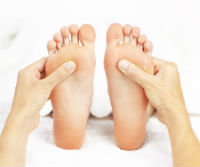A busy butterfly lives just below your Adam's apple that is responsible for the regulation of your inner state of balance, or homeostasis. Like a butterfly, the thyroid quietly goes about its business without getting much attention until your doctor checks it with her hands during a routine exam. Unless something unusual is found at that time (e.g., swelling) or symptoms manifest that indicate a problem, there won't be much further ado about your thyroid.
Let's take a moment to find out what the thyroid does, how to know if there's a problem, and how to keep your thyroid healthy. The thyroid is part of the endocrine system, which includes the pituitary gland, hypothalamus, thymus, pineal gland, testes, ovaries, adrenal glands, parathyroid, and pancreas. It makes hormones (e.g., T3, T4) that travel through your bloodstream and regulate your metabolism, brain and heart function, and reproductive and menstrual cycles.
When the thyroid is not functioning properly, a chain reaction of hormonal events takes place that involves many other glands/hormones of the endocrine system and the bodily systems they regulate. The end result is one of two primary types of health conditions: hyperthyroidism or hypothyroidism
Hyperthyroidism results when the thyroid is overactive. Think of hyperthyroidism like a butterfly that can't stop fluttering its wings. Everything is on overdrive, including metabolism, frequency of bowels, emotions (anxiousness), increased sweating, and--for lady butterflies only--very light menstruation or cessation of the menstrual cycle. This butterfly often feels hot and can't maintain a healthy weight. There are also bouts of exhaustion from trying to maintain this intense state of arousal.
Hypothyroidism results when the thyroid is underactive. This butterfly just can't get its wings to go. It's gained weight, feels sluggish, and has brittle hair and nails. It feels cold and tired, is kind of depressed, and suffers from constipation. The lady butterflies usually have irregular, heavy menstruation.
5 Ways to Keep Your Thyroid Healthy
- Eat from the sea. The sea provides many natural sources of iodine, a building block of the thyroid hormone. Salt has a high concentration of iodine, but it can raise blood pressure. Instead, opt for saltwater fish, or try seaweed in a salad. Cod and halibut are high in selenium, which protects the thyroid gland during periods of stress and helps regulate hormone synthesis. Fish oil provides essential fatty acids that reduce inflammation, which plays a role in causing autoimmune diseases.
- Eat from the earth. Eat foods high in B vitamins, which are precursors to thyroid hormones and influence cell energy. Balance your diet with poultry, nuts and seeds, legumes, and whole grains. Red meat provides iron, zinc, magnesium, and other minerals essential for thyroid hormone function, and the health of other bodily systems affected by thyroid disorders (skin, hair, metabolism).
- Relax. A daily relaxation practice, such as just 10 minutes a day of silence and deep breathing, can make a difference in the state of mind and body.
- Move it! Exercise at least 30 minutes a day. Yoga is particularly good for thyroid health, including poses such as butterfly, fish pose, shoulder stand, and child's pose.
- Get supplemental insurance. Our diets aren't perfect, so supplementing with a vitamin/mineral or botanical (herb) regimen can provide extra insurance against exposure to stress, toxins, and perhaps your own family history. Be sure to consult with Dr. Bossio about the best nutraceutical products for you.
Resources
Image Attribution: Blaj Gabriel/bigstockphoto.com






